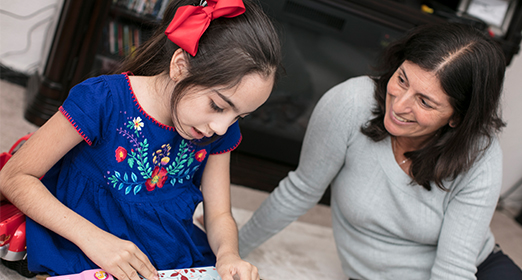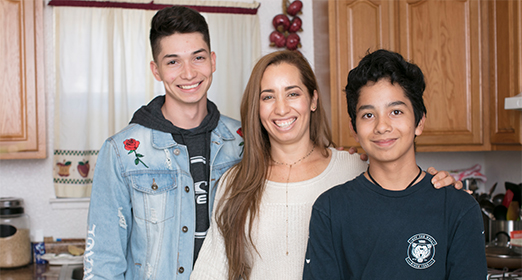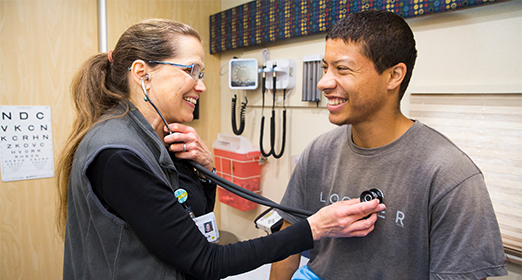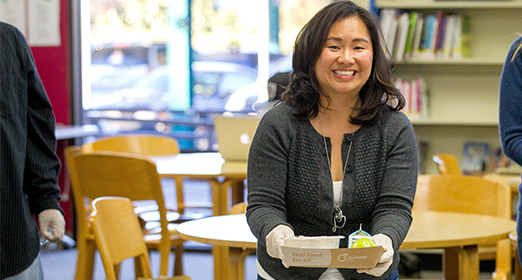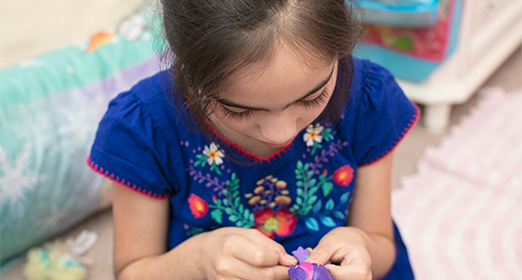Patricia Jimenez didn’t want to object too loudly, because if she did, she feared her landlord would evict her family from their apartment on the border of East Palo Alto.
She wrote him several letters requesting help with no success. Meanwhile, mold crept further up the walls and the back of their couch, and green slime coated the clothes in their closets. Her youngest son, Sergio Ramirez Jr., started to have serious breathing problems from inhaling the musty air. He was 5 years old at the time. Her daughter, Atzhiry Ramirez, who was 2, developed a persistent rash.
During an appointment at the Ravenswood Family Health Center in East Palo Alto, their pediatrician, Dana Weintraub, MD, asked about their home life. That’s when both women made the connection between the mold and the family’s deteriorating health. Weintraub wrote a letter to their landlord expressing her concern. Still, the landlord refused to take any action.
Someone on Their Side
Then Weintraub told Patricia about the Peninsula Family Advocacy Program (FAP), a collaboration between Lucile Packard Children’s Hospital Stanford and the Legal Aid Society of San Mateo County. Weintraub co-founded FAP with Legal Aid in 2004 to provide no-cost legal services to low-income pregnant women and families from Santa Clara and San Mateo counties whose children are receiving medical care at our hospital and several community clinics. Since the program’s founding, Legal Aid lawyers have provided advice, representation, or referrals to more than 4,000 individuals and families through FAP and trained hundreds of health care providers annually.
Patricia’s attorney convinced her landlord to finally get rid of the mold.
“When you’re Hispanic and an immigrant, I thought, ‘You’re asking for problems if you get a lawyer,’” she says. “But when my doctor told me about FAP, I thought that maybe it was okay because she was telling me about it. You don’t think you’re going to find that kind of help through a doctor. I never thought the two would be affiliated.”
It makes a lot of sense since patients often feel comfortable confiding in their doctor, and pediatricians like Weintraub, clinical associate professor of general pediatrics at Stanford University School of Medicine, are trained to recognize and help address the social problems that impact children’s health.
“In pediatrics, we can’t ignore the social context,” says Lisa Chamberlain, MD, MPH, associate professor of pediatrics, Arline and Pete Harman Faculty Scholar, and associate chair, Policy and Community Engagement. “If we know the stress level in a family, the support and resources we provide will be directed toward that child and change their outcomes.”
Rising Rents
Despite the affluence of Silicon Valley, 17.1 percent and 21 percent of children in Santa Clara and San Mateo counties, respectively, are living in poverty. New census figures show that California has the highest poverty rate in the nation because of its affordable housing crisis.
Chamberlain says families are coping by either leaving the Bay Area to find lower rents or staying but bringing another family into a two-bedroom apartment or taking another job. “People are finding alternative housing—you see it on El Camino Real with the RVs of people living there,” she says.
Fortunately, Packard Children’s cares for all children in our community, regardless of their economic circumstances. Approximately 40 percent of patients at our hospital rely on public insurance such as Medi-Cal. Expectant mothers and children from families of all income levels receive the same level of specialized care.
Packard Children’s also supports a network of community clinics located in East Palo Alto, Mountain View, Sunnyvale, Palo Alto, Atherton/ Redwood City, and San Mateo to form an important safety net for low-income families.
“As a children’s hospital, our responsibility is ensuring the health of all children. We’re a pillar of safety and security,” says Baraka Floyd, MD, who leads the doctors at Gardner Packard Health Center, which serves many low-income children from Redwood City.
Care on Wheels
When youth in need can’t reach a community clinic or are uninsured, there is one more resource. For them, the Teen Health Van mobile clinic visits multiple sites from San Francisco to San Jose to provide comprehensive health care services. Each year, the Teen Health Van treats approximately 400 homeless and uninsured youth ages 10 to 25 free of charge. Philanthropy helps cover the $750,000 annual operating cost.
“When I started this program 22 years ago, I thought the problem of youth homelessness would be solved by now,” says Seth Ammerman, MD, medical director for the Teen Health Van.
Instead, Ammerman says, the problem is getting worse. To address the need, the Teen Health Van recently added sites at Mountain View High School and San Mateo High School.
Through the Cracks
Other children who could fall through the system’s cracks are those with medical complexity, but Karen Wayman, PhD, director of Family Centered Care at Packard Children’s, won’t let that happen. Our hospital treats some of the sickest children anywhere, and while they survive major illnesses or cope with chronic conditions, their ongoing needs for care are immense.
“They are one of our most vulnerable populations who need help and are less likely to have the skills to access the health care system,” says Wayman.
Children with medical complexity have multiple medical visits with different doctors and therapists and take many medications. Their parents struggle to handle their care along with managing the rest of family life, says Wayman. Often one parent must give up employment to focus on their child’s care.
That’s when the CORE (Coordinating and Optimizing Resources Effectively) program jumps into action. CORE goes to the clinic or bedside to provide care coordination and communication between the patient’s family and their multiple caregivers, and among the caregivers themselves. Because of this proactive approach, CORE has reduced emergency department visits by 30 percent and inpatient admissions by 20 percent for the 400 children currently enrolled and 200 graduates of the program.
“Packard Children’s has a general mission for the health and well-being of children and their families,” says Wayman. “And if you’re dedicated to health, then you also have to address the other things that can impinge upon their health.”
Beyond helping individual families, physicians band together to shape policy at the state and national levels. One issue right now is family separation at the border, and Stanford doctors have been bringing to lawmakers evidence of how devastating it is for children in terms of their neurodevelopment and toxic stress.
No One Goes Hungry
Overall, immigration concerns place added stress on families. In some cases, children are born here and are U.S. citizens, but someone close to them might be undocumented. Out of fear and uncertainty, families may avoid public benefits like food stamps and the Special Supplemental Nutrition Program for Women, Infants, and Children.
“Families are bypassing things that they are legally entitled to have because of fear,” says Chamberlain. “The formal food safety net includes things like free and reduced-price school lunches and CalFresh, California’s food stamp program. As that normal food structure falls apart, which is happening right now, then the informal food safety net—the one you don’t have to register for—becomes really important.”
In 2011, Chamberlain founded the Summer Lunch Bridge program in East Palo Alto to address hunger when students are on summer break. Now called Lunch at the Libraries, the program has grown to serve kids and adults in Santa Clara and San Mateo counties. Anyone who shows up eats for free. No questions asked.
“Being able to fund a small, innovative pilot project like the one in East Palo Alto makes a difference,” says Janine Bruce, DrPH, MPH, who helped start Lunch at the Libraries with Chamberlain. “Small-scale things can have a ripple effect. This little thing we did feeding families through the libraries has become the norm. Something that starts small can potentially have a big impact.”
Next, Chamberlain hopes to offer free lunches for families in need while they’re in our hospital.
Talk, Read, Sing
Through their work in the community, pediatricians can also influence important issues such as literacy. Children in low-income families often start school at a disadvantage. In East Palo Alto, only 13 percent of kids are ready for school at age 5, compared to 90 percent in Palo Alto, according to Chamberlain.
“They’re starting behind in one of the biggest social determinants of health, which is education,” she says. “What kind of interventions can pediatricians be offering parents so that their children can be ready to start school?”
One effort is Talk, Read, Sing, a public awareness campaign offered by Packard Children’s and the community health clinics that provides parents with resources to guide how they play with their child to boost their early brain and vocabulary development. The Auxiliaries, which raise funds for undercompensated care at our hospital, donated more than $124,000 last year to Packard Children’s Talk, Read, Sing efforts.
“We want to start seeing a culture shift in the community,” Chamberlain says. “A big part of being a parent is this interaction with your child every day.”
How You Can Help
With more philanthropic support, Packard Children’s could do more to reduce poverty’s impacts on children’s health. Chamberlain hopes to introduce several innovative programs such as a subsidized diaper program and tax assistance at health clinics to help families claim their Earned Income Tax Credit. But she needs seed funding.
“Ideally we would have a suite of interventions to address poverty,” she says. “It’s about moving money back into people’s pockets.”
Thanks to FAP, Patricia Jimenez received the help she needed, and, more importantly, she learned how to advocate for the care and education of Atzhiry, now 9, who has autism. Patricia returned to Legal Aid for help resolving another landlord dispute and obtaining needed services for Atzhiry’s education.
“They told me about her rights and mine as a parent,” she says. “They gave me the security and empowerment to advocate for her. It’s important to make sure all kids have the same opportunities.”
The family now lives in a low-cost four-bedroom townhome adjacent to their old apartment and a busy freeway. Patricia stays home to care for Atzhiry and is taking classes to become a medical assistant. Her husband, Sergio Ramirez, works in construction. Their eldest son, Kennedy Jimenez, 19, goes to community college with aspirations of becoming a tech engineer, and Sergio Jr., 12, attends middle school in Menlo Park.
Atzhiry is now thriving in third grade at a special needs school in Menlo Park. She is an avid reader, especially of books about princesses, and she likes to wear pretty bows in her long brown hair.
“Perhaps donors can’t imagine the impact their donation could have on families like mine,” says Patricia. “Honestly, it is so important to families. My daughter has been able to get the services she needs. It might change our lives moving forward. It’s a huge impact.”
Your gifts to the Children’s Fund support care for all children, regardless of their economic situation. Please give at supportLPCH.org/donate.
This article originally appeared in the Fall 2018 issue of Packard Children’s News.
Photography credit: Ana Homonnay, Jacqueline Orrell Photography
